ICE 4 intercity train for Deutsche Bahn unveiled
Posted: 14 September 2016 | | 5 comments
Deutsche Bahn has unveiled the new ICE 4 at Berlin Central Station which it says will be the backbone of its long-distance transport system.
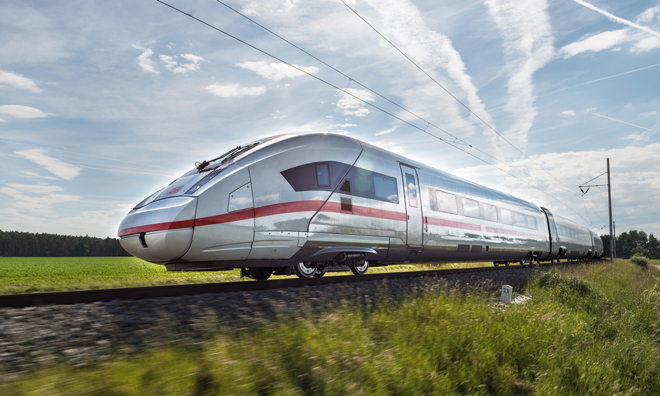

Deutsche Bahn has unveiled the new ICE 4 at Berlin Central Station which it says will be the backbone of its long-distance transport system.
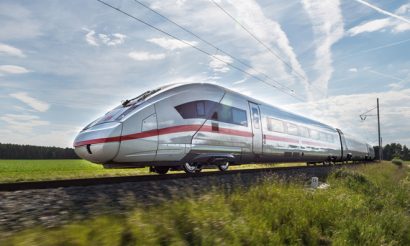

Image: Siemens
The Siemens built ICE 4 was presented today (14 September 2016) by Dr. Rüdiger Grube, Chairman of the Management Board and CEO of Deutsche Bahn, and Alexander Dobrindt, German Minister for Transportation and Digital Infrastructure.
“The ICE 4 ushers in a new era: it is the backbone of our future long-distance transport system”
Speaking at the ceremony, Dr. Rüdiger Grube said: “The ICE 4 ushers in a new era: it is the backbone of our future long-distance transport system. We are planning to expand our range of long-distance rail services by 25 percent by the year 2030, linking up more and more cities and regions. This new flagship will make a lasting contribution towards the future viability of the DB Group,”
ICE 4 can run at a top speed of 250 kilometres per hour
The 12-car ICE 4 can run at a top speed of 250 kilometres per hour and has an overall length of 346 metres. In total, there are 830 seats, 205 in first class and 625 in second class. It aerodynamic design helps to reduce energy consumption per seat by 22 percent compared with a modernised ICE 1. Furthermore, its traction system uses power cars and permits flexible train formation.
Each train will feature real-time information displays regarding journeys and connecting trains at each station and a parent-and-child compartment and family area. In addition, the ICE 4 has space for eight bicycles and four wheelchairs. Two on-board hoists ensure that wheelchair users can board and leave the train at all stations.
Internal features also include, lighting within each carriage which adjusts creating a different ambiance depending on the time of day. Seat numbers and reservation signs are now integrated within headrests and passengers in first and second class will be able to make use of state-of-the-art WiFi and telephone technology – DB has assured that this will be installed in its entire ICE fleet by the end of the year.
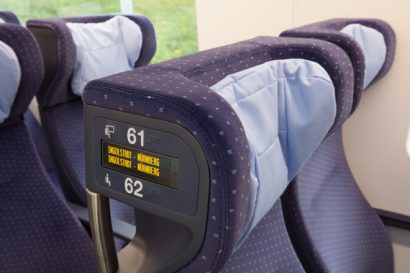

Integrated reservation sign on the headrest
“ICE 4 is a key step towards the digital railway, a modern mode of transport for the Gigabit Society”
Commenting on the introduction, Minister for Transportation Alexander Dobrindt said, “25 years ago, the ICE heralded the dawn of a new mobility era and quickly became an export hit. Today, the ICE 4 is the most modern and customer-friendly upgrade of high-speed train travel, thanks in part to free WiFi in the first and second class cars. I am confident that the ICE 4, like its predecessors, will become another showcase for quality made in Germany and an example of Deutsche Bahn’s innovative leadership. The ICE 4 is a key step towards the digital railway, a modern mode of transport for the Gigabit Society.”
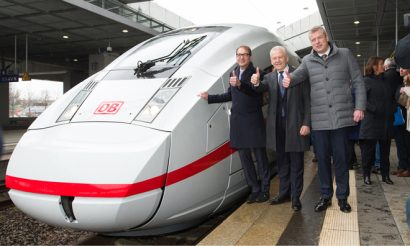

From right to left: Jochen Eickholt, CEO of the Siemens Mobility Division Rüdiger Grube, Chairman and CEO of Deutsche Bahn
Alexander Dobrindt, the German Minister of Transport and Digital Infrastructure. Image Siemens
Dr. Roland Busch, Member of the Managing Board of Siemens AG, said: “The ICE 4 sets new standards for rail travel in Germany. It contains the entire expertise and energy of our engineers. The train features numerous technical innovations: a completely new traction system, significantly lower energy consumption and more comfort for passengers. Moreover, the project is right on schedule, thanks to the hard work put in by Siemens and Deutsche Bahn.”
The ICE 4 will be the first high-speed train in Europe to undergo an introductory phase that will last several months before it goes into regular service in December 2017. During this period DB will test the reliability of the train’s technical components and systems under real operating conditions. During the introductory phase – which is about to commence – two ICE 4 trains will be used occasionally on the Hamburg–Hanover–Nuremberg–Munich line in Germany.
Today’s ceremony marks the first delivery of 130 trains from a total of up to 300 trains covered by the 2011 framework agreement with Siemens in May 2011.



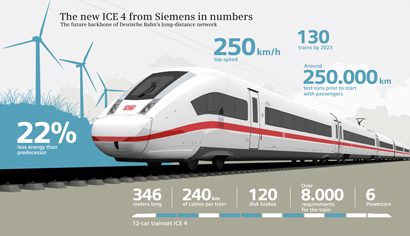
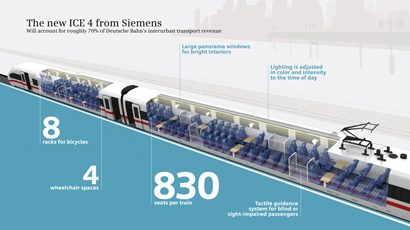
Only spaces for four wheelchairs – disgusting – there should be one in at least every coach.
This “relatively small” amount of wheelchair spaces was just done to meet the requirements of the Deutshce Bahn. In Germany there are not such high requirements placed on amount of spaces for wheelchairs as for example from the ADA in America. So in order to optimize the amount of space there are “only” four wheelchair spaces in the basic layout, which are all in one car. That means that the corresponding space needed for larger gangways, restrooms, and lifters (for different platform heights) are also located in just one car. However the complete interior of the train was made so flexible, that if the DB sees that they would need additional wheelchair spaces, they can easily reconfigure the seating areas to accommodate for more.
There are also eight reserved seats at the end of each of the cars for persons with reduced mobility.
“Top speed of 250 kilometres per hour”? That’s c***, France’s TGVs go at up to 360 kilometres/hour at cruising speed.
What for, if there is not so many straight railways in Germany where cruise speed of TGV is needed? Energy efficiency is more important than constantly speed up and speed down just because the train does 350 km/h. The more efficient is the train the cheaper are tickets.
Siemens of course had initially offered their Velaro platform trains to the Deutsche Bahn, which also travel up to 360 km/h. (see https://en.wikipedia.org/wiki/Siemens_Velaro#Velaro_D_.28DB_Class_407.29)
However the DB did not see the necessity for additional very high speed trains for various reasons (as Stich also indicated).